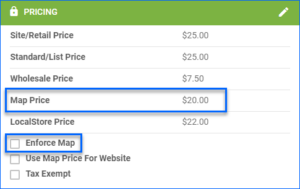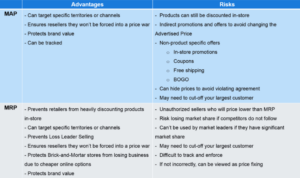Pricing products can be a tricky thing.
Most people will be familiar with “MSRP”, which is what we use as a benchmark for when a new product enters the market.
Then there is something called “MAP pricing.” And no, it has nothing to do with geography. It actually has everything to do with marketing and advertising.
But what is MAP pricing? And why is it important? It’s a terrific question, and one that every marketer ought to ask, especially in the natural products industry.
What is MAP Pricing?
Alright, let’s get into it. MAP pricing (short for Minimum Advertised Price), is the lowest price at which a retailer can advertise a manufacturer’s product for sale.
Unlike the actual selling price, which can vary, MAP sets a floor for the advertised price, which makes sure retailers don’t publicly advertise prices below what they’re allowed.
Essentially, it preserves a level playing field among retailers, preventing price wars that could devalue products and erode brand equity.

This is a hugely important standard to set for product brands that are expanding their distribution channels through retail outlets. If MAP did not exist, retailers might be tempted to sell a product at a cost far below what is sustainable for future production. When this happens for too long, potential customers will assume the actual perceived value of the product is much lower than it actually is.
Let me give you an example to show you what I mean.
Let’s say a brand sells nootropic supplements for $14 per bottle and it costs them $4 to produce and ship each unit. They partner with several retailers and establish a MAP policy that prevents the retailers from selling the supplement for less than $8.
Since selling it for any less would not only result in a loss compared to the cost it takes to produce, and ship the supplement, it is also so far below the originally-valued price that it creates the impression that the product is actually worth $8. Once that impression sets into the minds of the audience, it’s difficult to reverse it.
MAP vs. MSRP: What’s the Difference?
While MAP and MSRP might seem akin to each other, they are actually quite different! And They each serve very distinct purposes in the retail ecosystem.
- MSRP, or Manufacturer’s Suggested Retail Price, acts as a guideline proposed by the manufacturer, suggesting the price at which retailers could sell the product.
- MAP, on the other hand, is a contractual agreement between manufacturers and retailers, stipulating the minimum price at which the product can be advertised.
The crux here lies in enforcement. MSRP is never really enforced. MAP almost always is enforced.
Even though MAP and MSRP have different utility, they do have similarities. Check out some of the advantages and disadvantages of each pricing model outlined by IRIS Pricing Solutions below:

Unlike MSRP, which merely suggests a price, MAP is legally binding between manufacturers and retailers. It safeguards against price erosion and maintains a fair marketplace, ensuring healthy competition while preserving brand value.
It’s actually a good thing for both retailers and manufacturers alike, as it strips away this compulsion for the retailers to try and “edge out” their competition. Once there’s a pre-ordained price floor at which they can sell a particular item, it simplifies it for everyone, including the retailer.
Why MAP Pricing is Crucial with Natural Product Sales
When it comes to natural products, it’s no secret that more time, effort, and resources are poured into making the product a notch or two above processed goods in terms of quality. It’s what people look for in any type of luxury good or higher-quality consumables after all!
Consumers with the buying capacity for your holistic products want to feel like they’re getting value for what they’re willing to pay. I’m sure we’ve all been there at some point. You’re ready to dole out some cash for something with better quality than you could find at a Wal-mart. With that mindset, you’re willing to spend a bit more than you would for a lesser-quality item.
And here’s the kicker. In most cases, people would rather spend more for a higher-quality product than spend less. It all ties back to the perception of value.
Let’s go back to that hypothetical nootropic brand for a second.
The nootropic company is committed to delivering a quality alternative to highly-processed pharmaceuticals. So, it goes through extra steps to ensure the ingredients for their supplements are sourced ethically, are grown to the highest quality possible, and cut no corners in their concentration and potency of active components. Their place in the market is to provide a higher standard for consumers that want a higher-quality solution for their needs.
Because of all of the effort they put into making their products top-notch, they can afford to (and quite frankly, have to) charge more premium pricing for a more natural, holistic option! And as such, they’re creating the perception that their products are high-quality – to match deservedly higher price points.

Now, think for a minute. If retailers came into the picture and quashed that value-based pricing perception by slashing prices, essentially tarnishing the perceived quality of the supplements, what do you think would happen to the product line?
Kind of a problem, isn’t it?
That’s where MAP pricing plays an instrumental role in maintaining the integrity and perceived value of natural product offerings.
Natural product sales thrive on trust and credibility. MAP pricing aligns with these principles, ensuring that retailers promote these products without devaluing their quality through aggressive pricing strategies.
The Ways MAP Pricing Protects Natural Product Brands
MAP pricing isn’t just about maintaining price parity; it’s a strategic tool that shapes consumer perceptions and sustains brand value.
Here’s a few reasons why it matters:
- Preserving Brand Integrity: MAP pricing safeguards the brand equity and image of natural products. By preventing deep discounts, it upholds the perceived value and quality associated with these offerings.
- Encouraging Fair Competition: It promotes healthy competition among retailers based on service, expertise, and customer experience rather than a race to the bottom solely on price.
- Empowering Manufacturers and Retailers: Manufacturers can maintain control over their product’s positioning in the market, encouraging better relationships with retailers while ensuring a consistent brand narrative.
- Enhancing Consumer Confidence: Consistent pricing reinforces consumer trust. When customers know they can find a product at a fair price across retailers, it cultivates confidence in their purchasing decisions.
The Road Ahead
Whether you’re a new natural product brand just opening the door to retail distribution, or you’re a seasoned brand that is re-evaluating your products’ placement in retail channels, MAP pricing is a vital component of any high-end product line, especially in the natural products segment.
It champions fairness, sustains brand credibility, and shapes a marketplace where quality takes precedence over pricing battles.
Now it’s time for you to develop a MAP policy for your own brand. Look at the margins you’re receiving from your products. Ask yourself how much you’ll let bundled or discounted pricing through retailers devalue your products.
I know, it’s a little scary to hear that word: “devalue.” If we’re being honest, it’s the message you send to your target audience through your retailers when you broker deals for discounted pricing.
To that end, craft your MAP policy intentionally, and weigh the costs of higher price floors and diminished brand equity!
Want to grow your business, reach more people, and change lives? Listen in to our podcast for expert insights, inspiring stories, and strategies that propel your natural products business forward!
